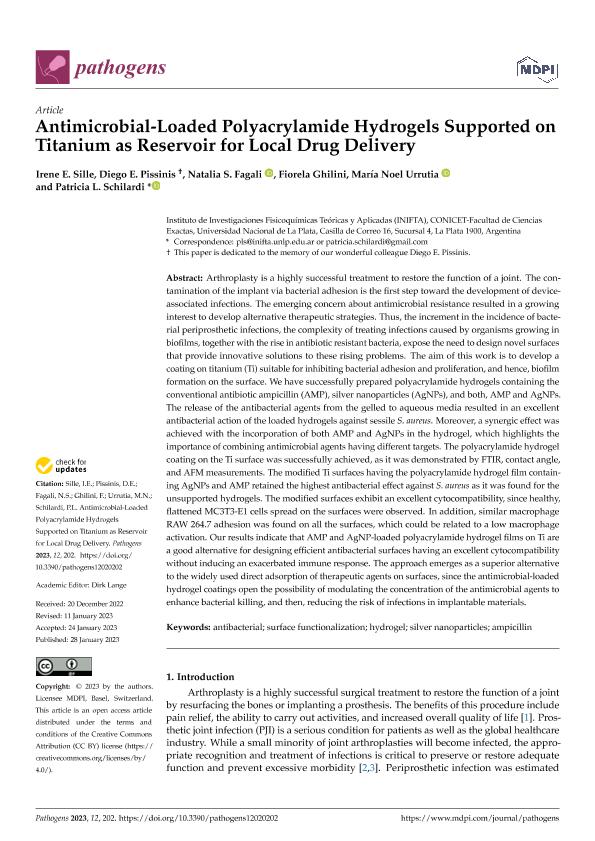Artículo
Antimicrobial-Loaded Polyacrylamide Hydrogels Supported on Titanium as Reservoir for Local Drug Delivery
Sille, Irene Elisabeth ; Pissinis, Diego Ezequiel
; Pissinis, Diego Ezequiel ; Fagali, Natalia Soledad
; Fagali, Natalia Soledad ; Ghilini, Fiorela
; Ghilini, Fiorela ; Urrutia, María Noel
; Urrutia, María Noel ; Schilardi, Patricia Laura
; Schilardi, Patricia Laura
 ; Pissinis, Diego Ezequiel
; Pissinis, Diego Ezequiel ; Fagali, Natalia Soledad
; Fagali, Natalia Soledad ; Ghilini, Fiorela
; Ghilini, Fiorela ; Urrutia, María Noel
; Urrutia, María Noel ; Schilardi, Patricia Laura
; Schilardi, Patricia Laura
Fecha de publicación:
01/2023
Editorial:
MDPI
Revista:
Pathogens
ISSN:
2076-0817
Idioma:
Inglés
Tipo de recurso:
Artículo publicado
Clasificación temática:
Resumen
Arthroplasty is a highly successful treatment to restore the function of a joint. The contamination of the implant via bacterial adhesion is the first step toward the development of device-associated infections. The emerging concern about antimicrobial resistance resulted in a growing interest to develop alternative therapeutic strategies. Thus, the increment in the incidence of bacterial periprosthetic infections, the complexity of treating infections caused by organisms growing in biofilms, together with the rise in antibiotic resistant bacteria, expose the need to design novel surfaces that provide innovative solutions to these rising problems. The aim of this work is to develop a coating on titanium (Ti) suitable for inhibiting bacterial adhesion and proliferation, and hence, biofilm formation on the surface. We have successfully prepared polyacrylamide hydrogels containing the conventional antibiotic ampicillin (AMP), silver nanoparticles (AgNPs), and both, AMP and AgNPs. The release of the antibacterial agents from the gelled to aqueous media resulted in an excellent antibacterial action of the loaded hydrogels against sessile S. aureus. Moreover, a synergic effect was achieved with the incorporation of both AMP and AgNPs in the hydrogel, which highlights the importance of combining antimicrobial agents having different targets. The polyacrylamide hydrogel coating on the Ti surface was successfully achieved, as it was demonstrated by FTIR, contact angle, and AFM measurements. The modified Ti surfaces having the polyacrylamide hydrogel film containing AgNPs and AMP retained the highest antibacterial effect against S. aureus as it was found for the unsupported hydrogels. The modified surfaces exhibit an excellent cytocompatibility, since healthy, flattened MC3T3-E1 cells spread on the surfaces were observed. In addition, similar macrophage RAW 264.7 adhesion was found on all the surfaces, which could be related to a low macrophage activation. Our results indicate that AMP and AgNP-loaded polyacrylamide hydrogel films on Ti are a good alternative for designing efficient antibacterial surfaces having an excellent cytocompatibility without inducing an exacerbated immune response. The approach emerges as a superior alternative to the widely used direct adsorption of therapeutic agents on surfaces, since the antimicrobial-loaded hydrogel coatings open the possibility of modulating the concentration of the antimicrobial agents to enhance bacterial killing, and then, reducing the risk of infections in implantable materials.
Archivos asociados
Licencia
Identificadores
Colecciones
Articulos(INIFTA)
Articulos de INST.DE INV.FISICOQUIMICAS TEORICAS Y APLIC.
Articulos de INST.DE INV.FISICOQUIMICAS TEORICAS Y APLIC.
Citación
Sille, Irene Elisabeth; Pissinis, Diego Ezequiel; Fagali, Natalia Soledad; Ghilini, Fiorela; Urrutia, María Noel; et al.; Antimicrobial-Loaded Polyacrylamide Hydrogels Supported on Titanium as Reservoir for Local Drug Delivery; MDPI; Pathogens; 12; 2; 1-2023; 202-220
Compartir
Altmétricas



